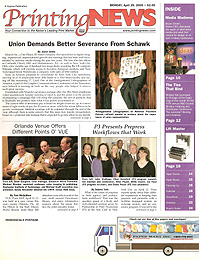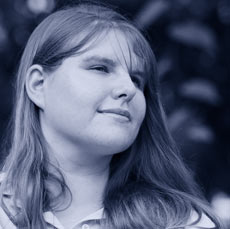|
  Apr. 25, 2005—VUE/Point 2005, April 11–13, was held at a new venue this year—sunny Orlando, Fla. At the Hilton in the Walt Disney World Resort, more than 260 attendees were able to soak in the sun, stroll around Downtown Disney, and enjoy informative sessions about the issues that face the print industry today. Apr. 25, 2005—VUE/Point 2005, April 11–13, was held at a new venue this year—sunny Orlando, Fla. At the Hilton in the Walt Disney World Resort, more than 260 attendees were able to soak in the sun, stroll around Downtown Disney, and enjoy informative sessions about the issues that face the print industry today.
Billed as “truth from the trenches,” VUE/Point focuses on in-depth sessions where audience members interact with experts and peers to explore problems and concerns. This year, the catch phrases seemed to be “variable data” and “value-added,” coming up in almost every session, as panelists stressed that these are the things print shops need to focus on.
Managed by the Graphic Arts Show Co. (GASC), VUE/Point is set up so that attendees can choose the topics that interest them. The opening session, titled “What Kind of Business Do I Want to Be?” set the tone for the seminar, highlighting fufillment, variable data, and value-added services as key points for survival in a new print world.
Steven Amiel, senior vice president, Unimac/SCI, Carlstadt, N.J., said that fufillment is a big category for printers that should be taken advantage of.
However, the panel did not advocate abandoning print. “Everything we do is really to drive the print. Print is still our number one revenue generator,” said Al Kennickell, president, Kennickell Print, Direct Mail and Fufillment. He told the audience that his Savannah, Ga.-based company offers a variety of complimentary services designed to add value to their client transactions.
Mr. Amiel went on to note that it is important for printers to look carefully at their own markets and company, and create applications where there are few or no competitors. Printers should identify what their ideal customer looks like, then create programs and services that cater to that type of customer’s needs.
The Perfect Printer
In “What Do I Want in My Printer?” print shop owners heard from a panel of individuals who all work in the print procurement business.
Joe Duncan, vice president of print innovation and technology at Leo Burnett, Chicago, started out the session by noting that it is important for printers to carve out a market. He said that, for his firm, communication is more critical than a single piece, and it often takes a combination of messages to reach end-users.
In response to a question from the moderator, John Zarwan, J Zarwan Printers, Charlottetown, Canada, who wanted to know what the panel looks for in a printer, Charles Richard, director of imaging services at Rochester, N.Y.-based Eastman Kodak Co., noted several key components: quality, and the capabilities to get the work done. He said that Kodak requires printers who wish to work with them provide an equipment list and a basic rate card. From there, “[We] beat you up on cost.” The panelists agreed, however, that it was important for a printer to be more than just a printer. All of them said that they wanted a partner in communications.
RGB vs. CMYK
The panel titled “How I Learned To Love RGB” debated the issue of working in an RGB or CMYK color space. The panelists all agreed that they prefer to work in RGB up until the time the file is RIPed for proofing and printing.
“There are almost no disadvantages to RGB,” said Michael Graff, executive vice president of Sandy Alexander, Clifton, N.J. “We have found it to be instrumentally valuable in process and workflow.”
The moderator for the panel, Larry Warter, director new business development, Enovation Graphic Systems, Valhalla, N.Y., noted, however that RGB is not for everyone. It depends on workflow, manpower, commitment, and a variety of other factors.
The Perfect Proof
In the “Proofing Today” session, panelists explored soft proofing and how it is changing the print industry. Some of the major benefits discussed included faster turnaround time, and cost savings.
One topic that was debated between the audience and panelists was the subject of color in soft proofing. Audience members wanted to know what they could tell customers to get better color from the files right from the start. Panelists suggested that printers make ICC profiles available to customers.
According to Jim Simddy, technical director, Blanks Printing & Imaging, Dallas, the biggest challenge to remote/soft proofing is that humans resist change. Too many clients still want to have something to hold in their hand, and overcoming this is going to be the most difficult part of switching over for a printer.
The Brand Game
In “Selling To the Brand—Enough with the Print Buyer,” value-added services was once again the main theme. The panel, made up of individuals who handle both print sales and print buying, stressed that partnerships and services, more than price, often determine who gets a job.
Steve Malloy, owner of Winter Park, Fla.-based Megaprints, has found that clients are willing to pay a premium for one-stop-shopping, as they like to be able to go to one place and get all the work done. This saves them time and money in the long run, and ensures a consistent message across a marketing campaign.
Pressed into Service
In the session “Musical Presses—A Look at the Blurring Line for Run Corssovers,” panelists looked at how they divide work up among their presses. Panelists agreed that most of the time, clients don’t care what kind of presses a shop is running, they just want their work to come out correct the first time. They once again stressed that value-added services make a big difference when it comes to selling print jobs. Some of the services the panelists highlighted include: letter shop/mailing; partnering with a digital shop for variable data; and finishing and creative services.
The Dreaded RFI/RFP
The differences between RFIs and RFPs and how to handle them were explored in the session “How To Deal with the New World of RFIs and RFPs.” The session included panelists from various segments of the industry, but the most hotly debated topic involved panelist Tanya Hernandez, vice president and director of production services for chemistri, Troy, Mich. Her agency handles all of General Motors public relations and advertising work, which is ultimately decided on price.
Printers in the audience wanted to know how it was fair that, if a print shop came back to her with a better idea after an RFP went out, that she re-bid the job to all the printers involved. They felt that this discouraged printers from trying to be partners, and encouraged the commoditization of print. Ms. Hernandez agreed that basing it on price is not necessarily the best way to go about choosing a printer, even though that is her client’s policy. However, only those printers who they have had a good working relationship with, or those who they are intersted in working with, are invited to participate in the bidding process, rather thanopening the bids up to the general printing public. In other words, printers are pre-qualified.
All in all, VUE/Point 2005 proved educational, with dual sessions for every time slot. In fact, many companies attending had more than one person present to ensure they were able to attend every session. In addition to sitting in on inspiring and thought-provoking sessions, the more than 260 attendees also had a chance to network between sessions and at event-sponsored breakfasts and lunches.
|


